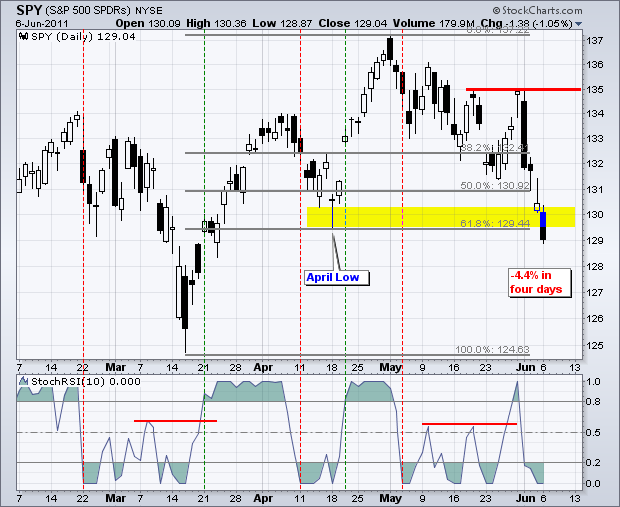The April lows are starting to break. The Russell 2000 ETF (IWM), S&P MidCap 400 SPDR (MDY) and S&P 500 ETF (SPY) broke their April lows. The Dow Industrials SPDR (DIA) and the Nasdaq 100 ETF (QQQ) remain just above their April lows. Weakness in the finance and consumer discretionary sectors pushed SPY below its April low on Monday. The finance sector has been chronically weak this year. The consumer discretionary was strong until early May, but was hit especially hard the last four days. As a result, SPY is down 4.4% in just four days, which makes it short-term oversold. Medium-term, we have yet to see a selling climax, a basing pattern or significant candlestick reversal to suggest a serious support level for the market. The late August low formed with a stalling pattern, the November low formed with a small W pattern and the March formed after a selling climax with a long black candlestick and quick recovery on high volume.

Key Economic Reports/Events:
Tue - Jun 07 - 15:00 - Consumer Credit
Wed - Jun 08 - 07:00 - MBA Mortgage Index
Wed - Jun 08 - 10:30 - Oil Inventories
Wed - Jun 08 - 14:00 - Fed's Beige Book
Thu - Jun 09 - 08:30 - Jobless Claims
Charts of Interest: Tuesday and Thursday in separate post.
This commentary and charts-of-interest are designed to stimulate thinking. This analysis is not a recommendation to buy, sell, hold or sell short any security (stock ETF or otherwise). We all need to think for ourselves when it comes to trading our own accounts. First, it is the only way to really learn. Second, we are the only ones responsible for our decisions. Think of these charts as food for further analysis. Before making a trade, it is important to have a plan. Plan the trade and trade the plan. Among other things, this includes setting a trigger level, a target area and a stop-loss level. It is also important to plan for three possible price movements: advance, decline or sideways. Have a plan for all three scenarios BEFORE making the trade. Consider possible holding times. And finally, look at overall market conditions and sector/industry performance.

